Regular readers of the PricePlow Blog are well aware that Kaged is one of the world's most formidable supplement brands. After removing the word "Muscle" from their brand name, the company has been attacking the wellness space, but their pre-workout supplements are still the heart of the arsenal.
In early 2022, Kaged released the potent Pre-Kaged ELITE pre-workout, which uses 10 whole grams of citrulline alongside other pump ingredients – something you don't often see. This was discussed in our recent podcast with formulator and founding partner Brian Rand, who reminded us that the original Kaged "PIP Stack" (which includes Pre-Kaged and In-Kaged) also includes nearly 10 grams of citrulline.
Why 10 grams of citrulline in Pre-Kaged Elite?!
It's true that in recent years, supplement manufacturers have been locked in a kind of "nitric oxide arms race", pushing doses higher and higher. To end users, it's become apparent that citrulline's benefits are likely dose-dependent, and weren't being maximized by the standard industry dose of 3-4 grams.
Kaged knew this in 2014, launching Pre-Kaged with an industry-leading 6.5 grams of citrulline. But with Pre-Kaged Elite, Brian Rand and the team took their citrulline game all the way.
So how did they choose the 10 gram figure, and why did they stop there? That's what we're going to talk about today.
But before we get into the science, sign up for our Kaged news alerts so that you don't miss announcements on that protein bar Brian teased in the podcast linked above:
Kaged Pre-Kaged Elite Series – Deals and Price Drop Alerts
Get Price Alerts
No spam, no scams.
Disclosure: PricePlow relies on pricing from stores with which we have a business relationship. We work hard to keep pricing current, but you may find a better offer.
Posts are sponsored in part by the retailers and/or brands listed on this page.
This area is reserved for Team PricePlow's upcoming Research Study video.
Subscribe to our channel and sign up for notifications so you catch it when it goes live!
Note: The first section of this article is a primer on L-citrulline and nitric oxide. If you already understand these topics, you can skip to the 10 gram research section below.
What is Citrulline and How Does it Work?
If you've spent much time at all in the sports nutrition space, you've undoubtedly heard a ton about L-citrulline. This is the industry's current go-to nitric oxide (NO) boosting supplement,[1] and has been for a few years now.
Why we supplement conditionally essential amino acids
Citrulline is a conditionally essential amino acid[2] that supports your body's generation of L-arginine, nitric oxide's precursor.[2,3] As a conditionally essential amino acid, this means that your body can actually produce some citrulline for its own uses, which will generally only cover your body's nutritional requirements under the best of circumstances. The caveat is that it can't produce enough for optimum function in certain situations, which is when supplementing can become quite beneficial.
Under more intense conditions, your body's need for citrulline is increased to the point where its production can't keep up with demand. In those cases, increased citrulline intake from food or supplements is needed for the body to function at its best.
Anyone who's training hard, dieting, or trying to grow muscle is likely in a state of heightened metabolic requirements, which is why we see conditionally essential aminos like citrulline appear so often in sports supplements.
So how exactly does citrulline increase your body's production of NO? And why is that a good thing?
How increased nitric oxide benefits performance and recovery
First, let's talk about nitric oxide. A rise in your NO blood levels triggers vasodilation, a mechanism that causes the smooth muscle lining your arteries to relax.[4,5] This in turn causes those arteries to expand in diameter, a simple change with tons of second-order benefits.
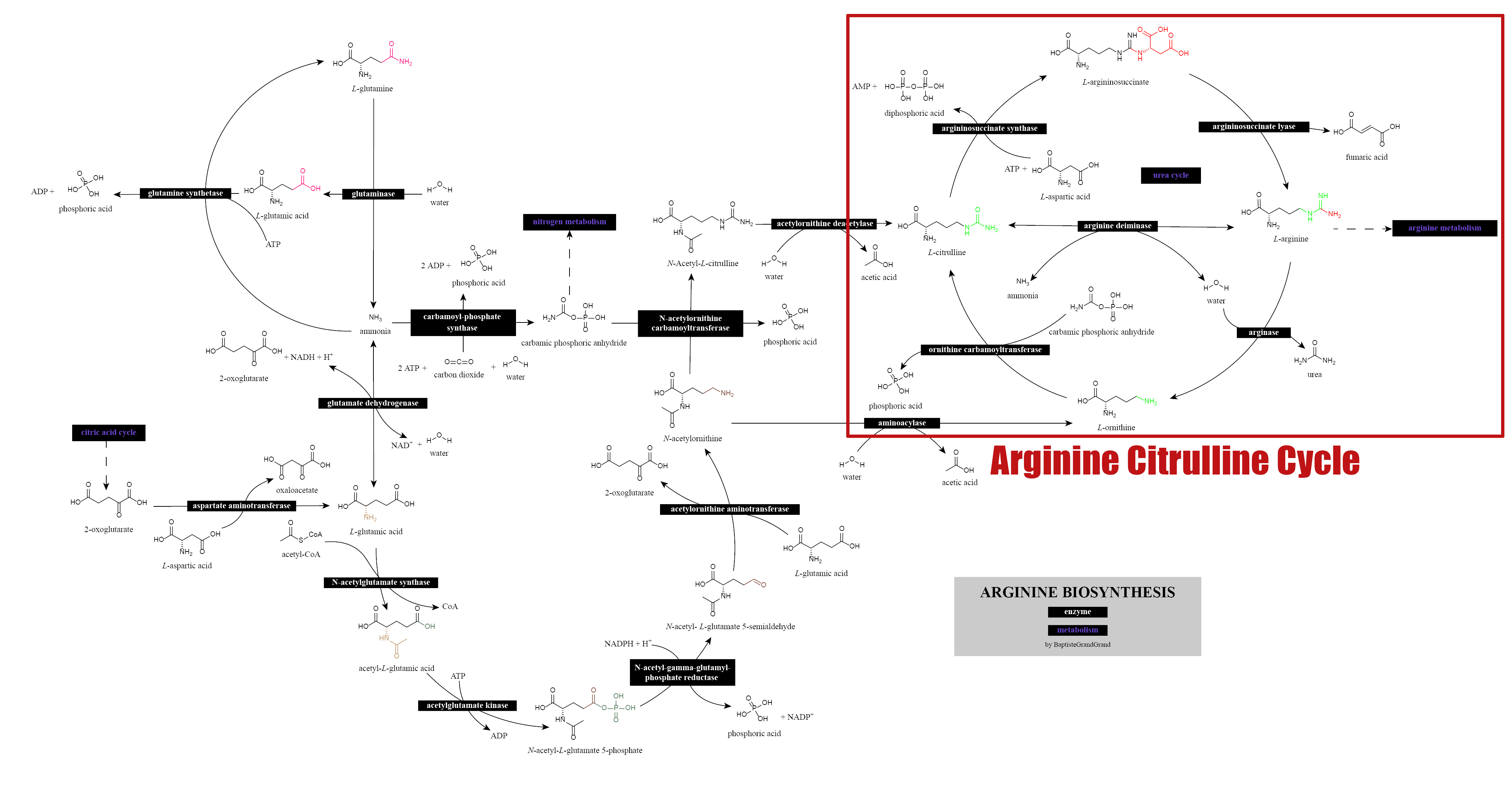
The Arginine Biosynthesis System. Image courtesy Wikimedia, with our red edits demonstrating the arginine citrulline cycle at the top-right (see next image for further details)
Bigger, more relaxed arteries means a sharp drop in blood pressure and heart rate, thanks to lower resistance across your whole cardiovascular system.[6-8] During vasodilation, your heart can move the same amount of blood with less work.
But the other big benefit is that your circulation improves. Vasodilation leads to an increase in what scientists call perfusion – the ability of blood to saturate healthy tissue.[9,10] The improvement in nutrient delivery and waste removal associated with this improvement in circulation can actually speed recovery from exercise, and potentially enhance muscular gains.[11,12]
The Conversion of Citrulline to NO
There's a little irony in citrulline being the standard NO boosting ingredient, which is that it's actually not the most direct precursor to NO production.
The amino acid arginine is what your body actually converts to NO – citrulline is the arginine precursor:
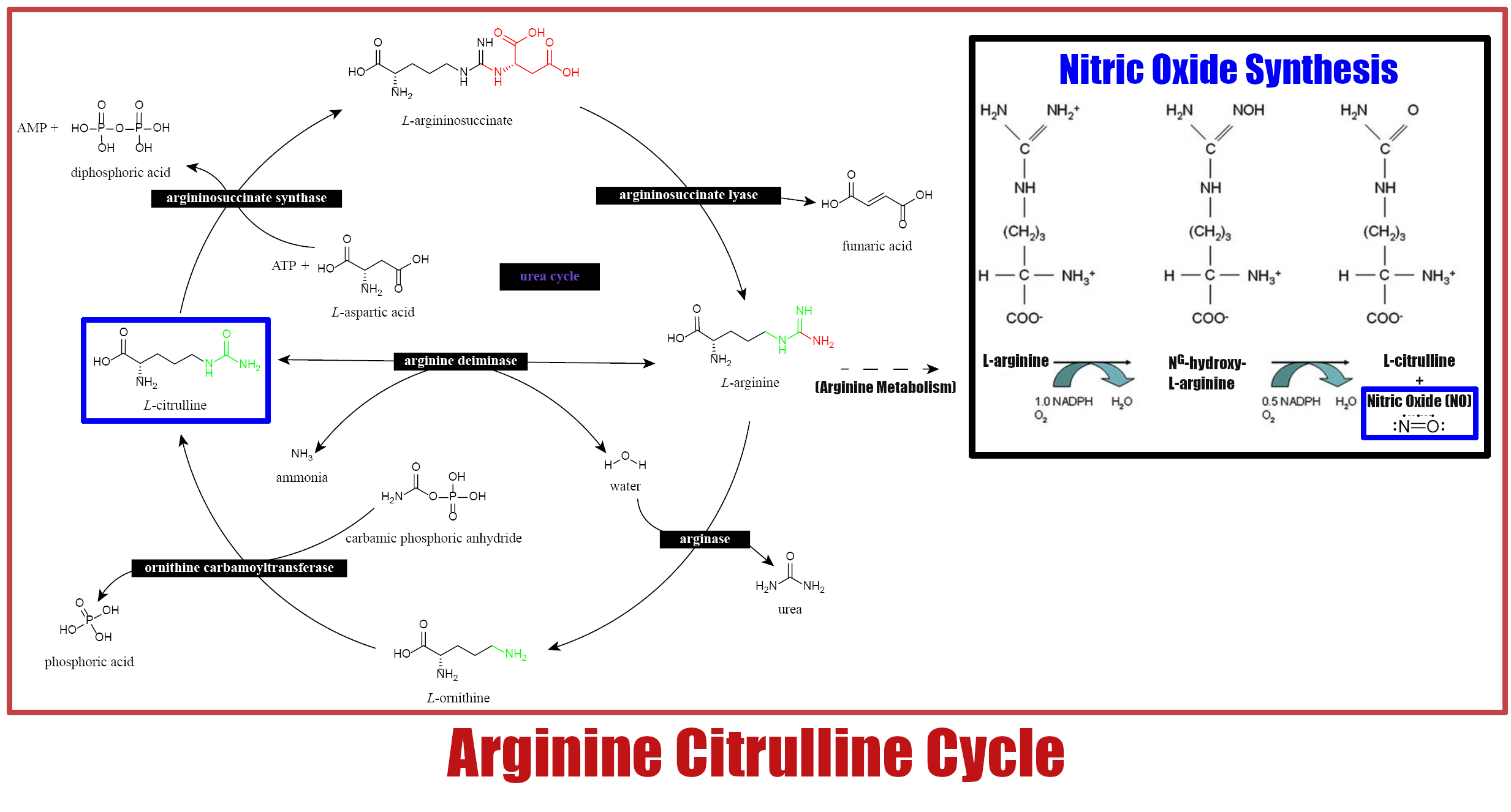
Citrulline → Arginine → Nitric Oxide (NO). The Arginine Citrulline Cycle with a breakout showing the arginine-to-nitric oxide reaction. Image courtesy Wikimedia with added biochemistry sources.[13,14]
At this point, most people ask why not just supplement with arginine instead? The answer is that while the oral bioavailability of arginine is pretty bad,[15-18] citrulline's bioavailability is quite good.[4,19,20]
Citrulline Research
With citrulline's general mechanism of action well understood, we have to answer the important question of what about citrulline-specific research? Does the theoretical benefit of upregulation NO with citrulline pan out in practice?
Yes - the studies on citrulline show that it can improve:
- Power output during exercise[21]
- Athletic endurance – a 50% increase[22]
- Soreness after exercise – a 50% reduction[22]
- Growth hormone secretion in response to exercise[23]
- Amino acid and protein catabolism[24]
- Muscle growth following exercise[25,26]
So yes, the answer is that citrulline is quite beneficial, especially for athletes. And there's even more that's not always covered:
Ornithine: an underrated benefit of citrulline supplementation
What's less appreciated about citrulline is that it can also increase your body's supply of ornithine.[27] This is important because of the role ornithine plays in your body's elimination of ammonia, which is yet another waste product of cellular metabolism.[28]
In fact, the buildup of ammonia in your brain and muscle tissues can cause both mental and physical fatigue. So aiding ammonia detoxification through ornithine is yet another way that citrulline can help boost endurance.
Citrulline even has downstream sleep benefits
We all know that sleep duration and quality are important factors in recovery from exercise – in fact, sleep is where most of our muscle gains happen. Turns out citrulline can help with this too, since boosting ornithine can decrease your body's ratio of cortisol to DHEA, which is an important marker of stress that's known to affect sleep quality.[28]
What you've read so far is more or less our standard discussion on nitric oxide and citrulline. You'll find similar content in most of our articles about citrulline-containing supplements. Now it's time to get into the nuts and bolts of this dosage.
Considerations In Citrulline Dosing – Why Use 10 Grams?
When writing about specific pre-workout supplements, we usually detail how the product's dose stacks up against the research literature.

Brian Rand and Team Kaged join the PricePlow Discord to talk about the Mindset Nootropic launch for PricePlow Podcast Episode #081!
But since writing about Pre-Kaged Elite and seeing the research, we consistently try to point out that serum arginine gains on citrulline don't start to diminish until you hit about 10 grams per day,[29] even though standard pre-workout doses are somewhere between 3 and 6 grams.
It was only a matter of time before one of the big players in the industry asked themselves "why not go whole-hog on citrulline and use the full 10 grams?" Well, as it turned out, Brian Rand and Kaged stepped up to the plate -- and right in the middle of an inflationary supply chain shortage, no less. That's how serious they are about this.
So, let's dig into the research on citrulline dosing, and help supplement formulators and laymen alike better understand the benefits of citrulline maxing.
Citrudose Pharmacokinetic Study 2007
The first study to discuss is a 2007 trial where researchers set out to establish the different pharmacokinetic effects of citrulline at various doses. That is, they wanted to see exactly how the body responds to different doses of citrulline.[29]
Their method for doing this was to load up 8 healthy, fasting males with different doses of citrulline in four different tests:
- 2 grams
- 5 grams
- 10 grams
- 15 grams
After the subjects ingested citrulline, the researchers took regular blood draws to track the concentration of citrulline, arginine, and ornithine in their bodies.
The researchers used this series of data to calculate the total activity of citrulline, arginine, and ornithine in the patients blood. We often represent the total activity of a given substance in the body as the area under the curve (AUC) of the graph.
The idea behind AUC is pretty simple: you are basically multiplying the concentration of something by the time it spends at that concentration.
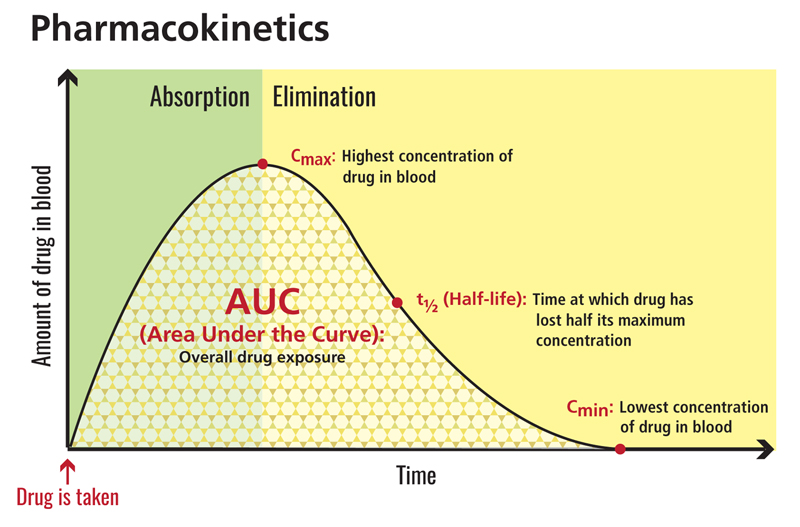
The area under the curve (AUC) of the plasma concentration of a drug or supplement is one way to calculate its total activity – or put another way, the total exposure of the person taking it.[30]
For example, let's say you have two different delivery systems for the same supplement: one rapid-release and one extended-release. The rapid-release supplement will almost always achieve a higher peak concentration, but also fall faster. The extended-release supplement will usually achieve a lower peak concentration, but will stay in your blood longer.
So which one wins? Generally speaking, whichever one has the bigger AUC, although your choices may also depend on your activities and desired timing.
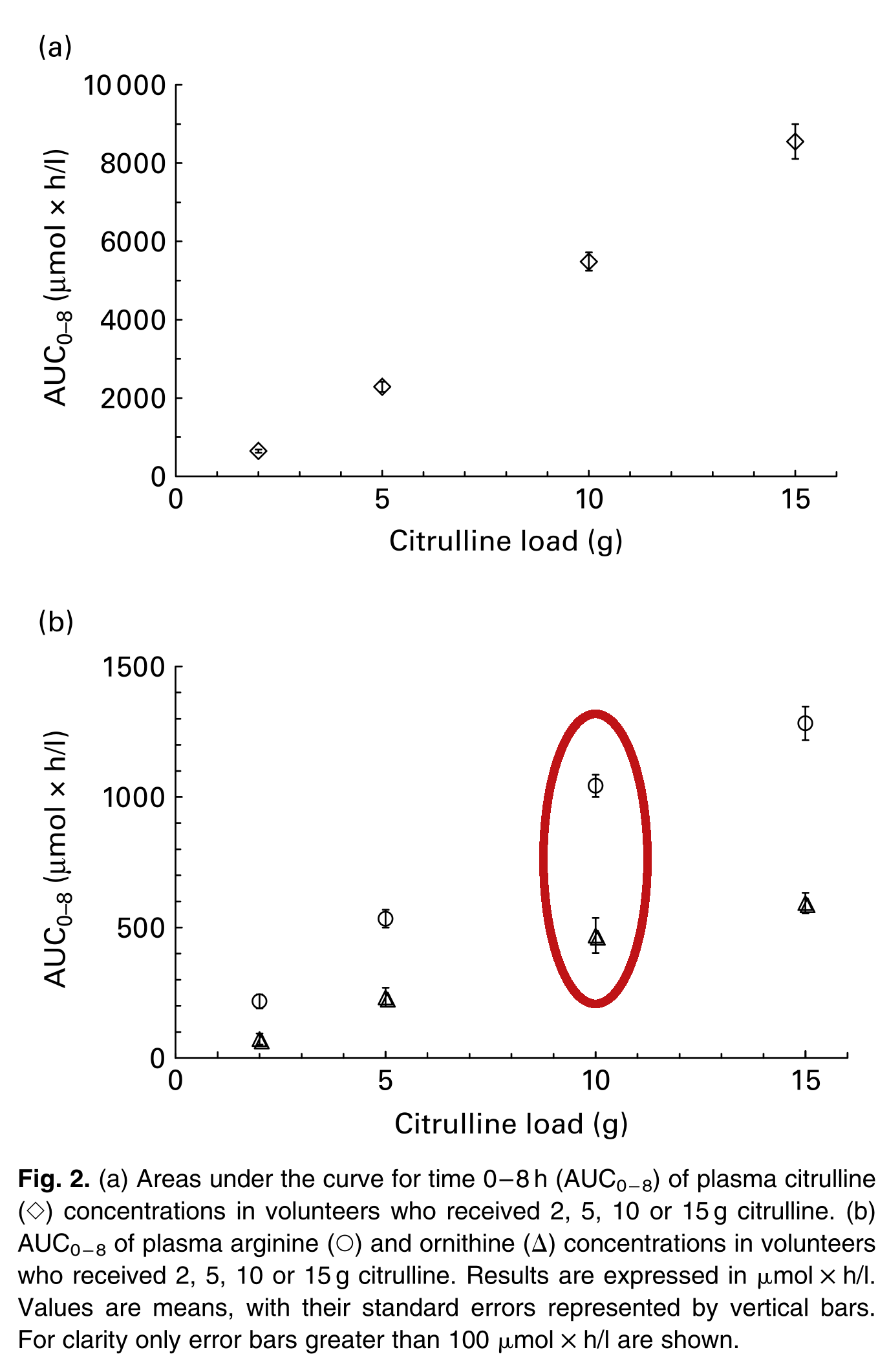
The results of the citrulline loading tests. In figure a), the diamond markers represent the total activity of citrulline in the subjects' blood. In figure b) the circles represent the total activity of arginine, and the triangles represent that of ornithine.[29]
Now that we understand what AUC can tell us, let's look at the AUC for citrulline, arginine, and ornithine in the study subjects:
What we can see from these two charts is that the AUC of arginine – the main target of citrulline supplementation – increased in a linear fashion between 0 and 10 grams of citrulline taken.[29]
Put simply, this means that within this range, if you double the citrulline dose, you get double the arginine activity. If you take 6 grams of citrulline, you'll get twice the arginine activity that you'd get at 3 grams of citrulline.
A 2018 study summarizing L-Citrulline's impact on cardiovascular health details the impact of this study, providing an excellent quote explaining the issues that come along with attempting equally high amounts of arginine:[31]
One such human study demonstrated a tolerance of up to 15 g l-citrulline per day in healthy volunteers.[29] By comparison, high-doses of l-arginine (~13 g) can induce significant gastrointestinal complications.[32,33] However, at 15 g doses of l-citrulline, a lower fractional absorption rate and plasma retention of l-citrulline was observed, potentially due to saturation of its transporters (e.g., ASC or B0,+-amino acid transporters) or reduced renal conversion of l-citrulline to l-arginine.
As such, the authors suggested a dose of 10 g l-citrulline for clinical use.[29] However, for increasing circulating l-arginine concentrations, doses of l-citrulline as low as 3 g have been shown to be effective.[4] Thus, the minimum effective dose is ~3 g/day, whereas the maximal effective dose may be as high as 10 g/day.[31]
But why not 15 grams?
So why not use even more than 10 grams? After all, in the figures we shared with you, the AUC for arginine keeps rising even when you increase the citrulline dose from 10 grams to 15!

Going from 10 to 15 grams of L-citrulline may have raised plasma citrulline levels dose-dependently, but the plasma arginine levels certainly didn't increase 50% alongside it! After 10, you hit the law of diminishing returns.[29]
The blockquoted summary above alludes to the answer - you effectively hit the law of diminishing returns. Every gram means more cost, more to ship, and more potential gastric overload. Past 10 grams, adding citrulline stops making economic sense - the additive effects of more serum arginine are no longer linear.
Just look at the chart again -- add 50% more citrulline at that point, you definitely won't get 50% greater ROI on serum arginine.
Additionally, Pre-Kaged Elite also has nitrates inside (from creatine nitrate), so it's not even the only nitric oxide ingredient!
Don’t forget the cGMP angle
Ultimately, our goal with citrulline supplementation is to increase vasodilation, a process that's mediated not just by citrulline and arginine, but also by cyclic guanosine monophosphate (cGMP), a second messenger molecule that actually triggers vasodilation in response to increased NO production.
Does more arginine lead to more vasodilation though?
So, next let's ask: does increased arginine activity from a bigger citrulline dose translate into more vasodilation?
Fortunately for us, this has been studied too. And the answer is yes.
Ine one study from 1998, researchers set out to statistically model the relationship between plasma arginine concentrations and vasodilation.[34]
They concluded that there's a direct correlation between plasma arginine levels and the extent of vasodilation. Here's a direct quote from that study:
"In the present study, the temporal pattern of L-arginine plasma concentration closely corresponded to the temporal pattern of its vasodilator effect, i.e., the reduction in total peripheral resistance and blood pressure. Pharmacokinetic/pharmacodynamic modelling indicated that the effect (reduction in TPR) was directly linked to L-arginine plasma concentration."[34]
We don't have any simple diagrams to share from this study, but basically, the researchers found a similar linear relationship between plasma arginine levels and vasodilation.
It's still important to remember that there are intermediary steps between citrulline ingestion and the ultimate desired effect -- which is not even arginine or NO upregulation -- but vasodilation.
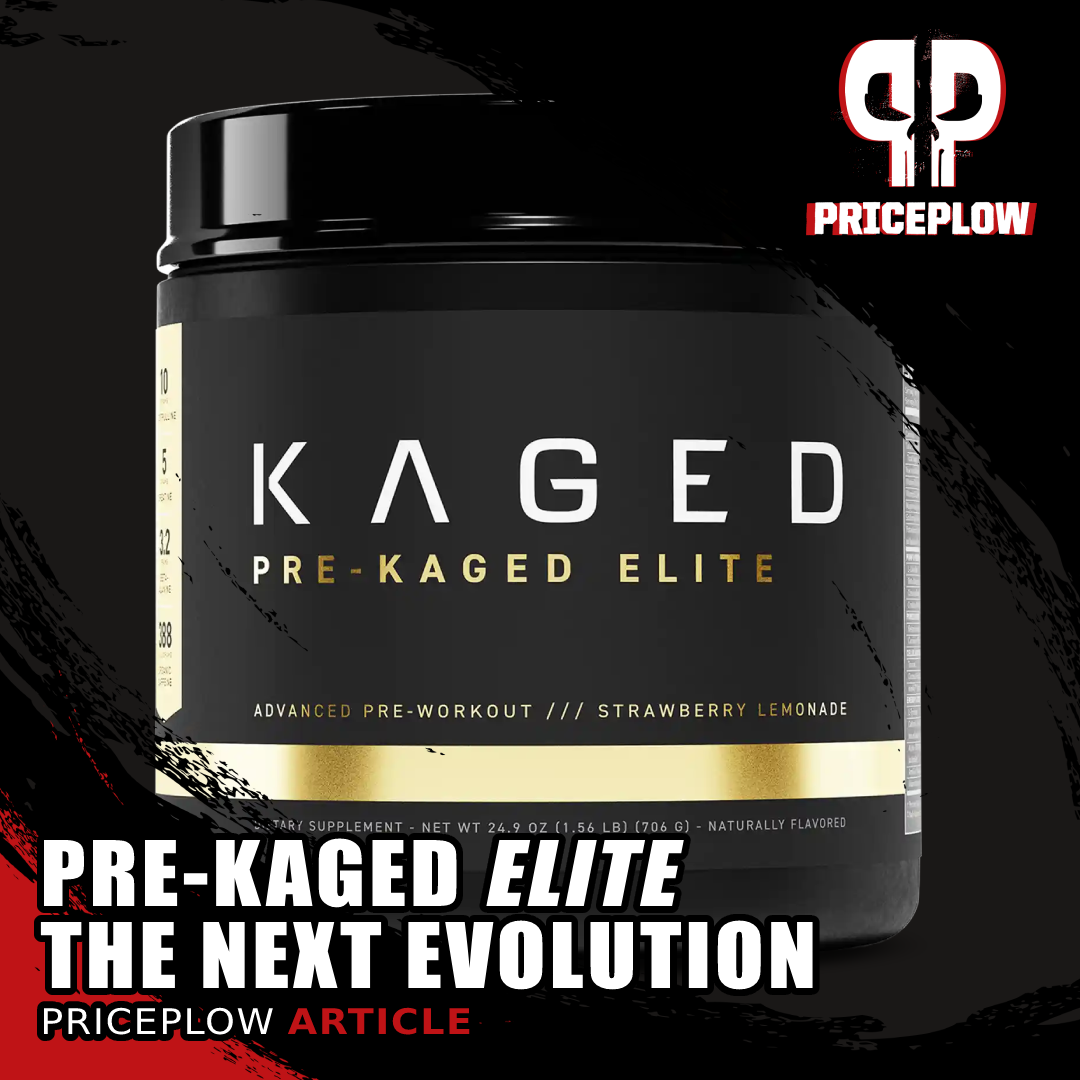
Pre-Kaged Elite takes pre-workout supplementation to new heights, featuring an insane 10 grams of L-citrulline in a protein-sized 35 gram scoop that's simply loaded!
Rest assured that when you get a bigger arginine AUC from citrulline supplementation, that is translating into additional vasodilatory effect.
Just ask anyone who's used Pre-Kaged Elite. The pumps are downright insane.
Conclusion: 10 grams is where to find the big bang for the bucks
So there you have it – based on current research, 10 grams of citrulline seems to be the magic number.
One thing to note is that the key study in this whole discussion didn't study any doses between 10 and 15 – so there's a possibility that the data could be refined in the future. We're not sure if the linearity continues through, say, 12 or 13 grams. So just in case, on top of the citrulline dose in Pre-Kaged Elite, the 2 grams of creatine nitrate more than adds a cherry on top.
Long story short, if you're looking for the most bang and are willing to spend the bucks, the research-based best practice with citrulline is to dose it at 10 grams. Brian Rand and Team Kaged have been near that dose in their original PIP Stack for quite some time, but with Pre-Kaged Elite, they make it official in one huge, dominating scoop.
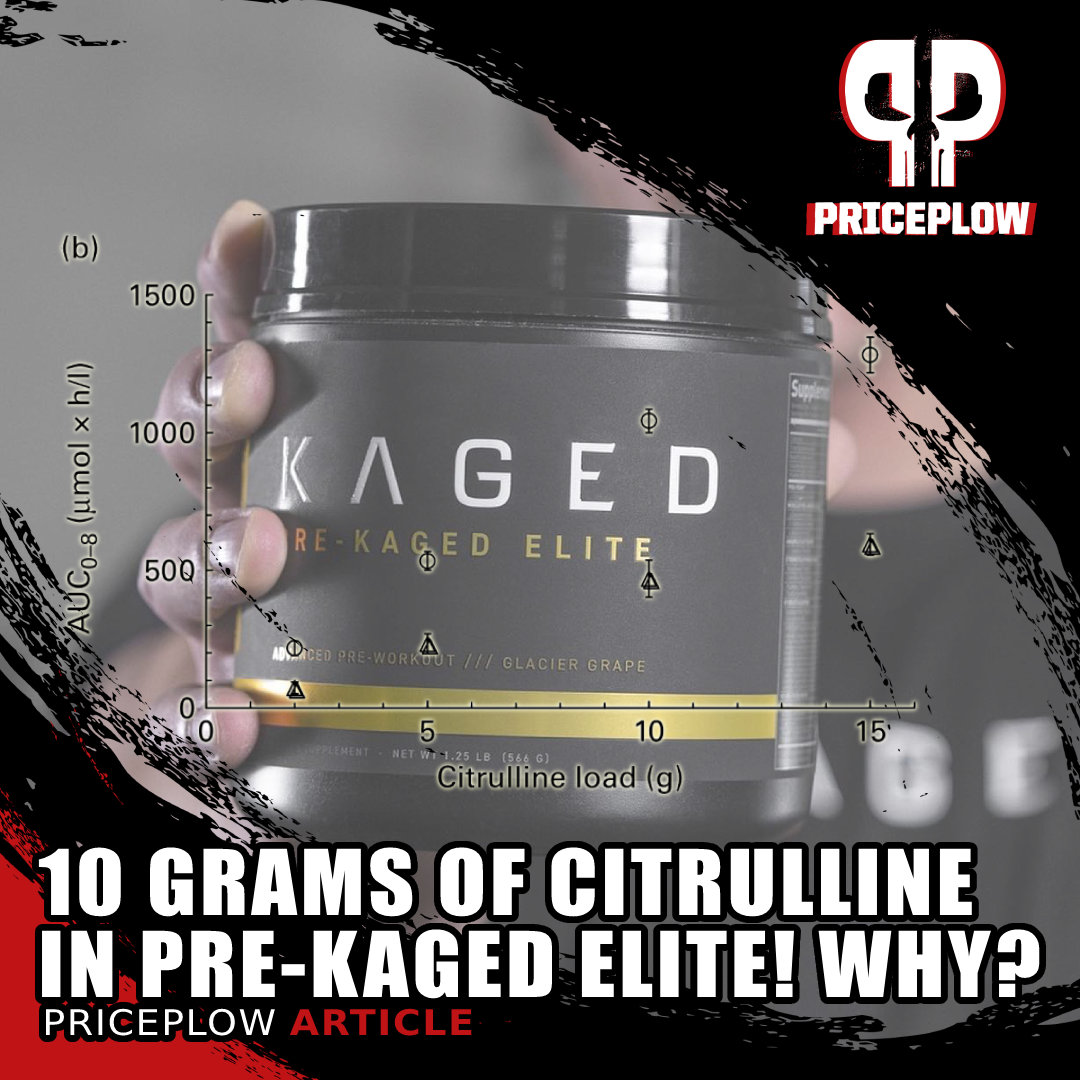
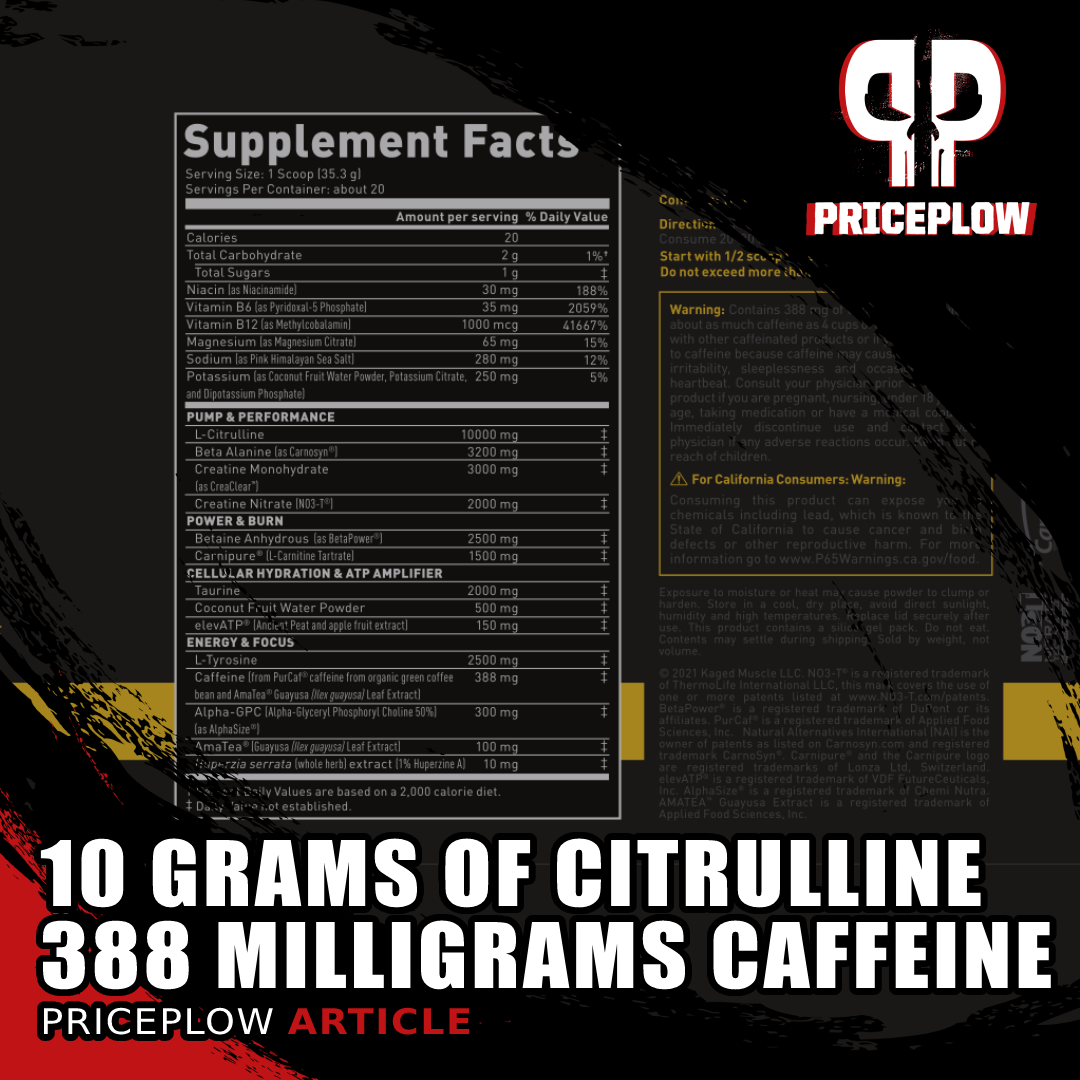


Comments and Discussion (Powered by the PricePlow Forum)